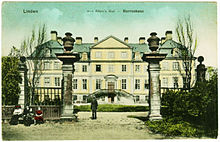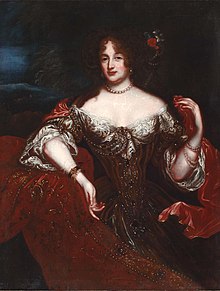Franz Ernst von Platen

Franz Ernst Freiherr (from 1689 Count ) von Platen (* 1631 in Erxleben (Börde); † 14. June 1709 ) was Lord Chamberlain and royal tutor in Hannover, Postmaster General and since 1689 Count as well as Privy Prime Minister of the Elector Ernst August of Hanover , the had made him the husband of his mistress in 1673. In 1704 he received the County of Hallermund , a small territory near Hildesheim that had been imperial since the Middle Ages , which is why he was accepted into the Lower Rhine-Westphalian Imperial Counts College in 1709, albeit only as a personalist .
With him came the Rügen dynasty of the Platen from Granskevitz (in Schaprode ) to Lower Saxony and into the service of the Duchy of Braunschweig-Lüneburg and its Calenberg line , which was elevated to electoral prince of Braunschweig-Lüneburg in 1692 .
Franz Ernst's official children (actually illegitimate descendants of the Elector Ernst August ) established the line of the Counts of Platen Hallermund , which still exists today .
Live and act
Franz Ernst's parents were the Swedish Colonel Baron Erasmus von Platen (* March 5, 1590 - March 15, 1663) and his third wife Margaretha Katharina von Alvensleben (* November 11, 1610; † November 11, 1670), daughter of Gebhard Johann I von Alvensleben (1576–1631). He spent his youth at his mother's castle in Erxleben , then was brought up by Jesuits in Hildesheim and studied law in Hildesheim and Altori.
Around 1659 he first entered the service of Duke Ernst August , who had been Prince-Bishop in Osnabrück since 1648 . Here he quickly rose to become a member of the newly established Secret Council. At the same time he held the position of court marshal . In 1664 he accompanied the Duke to Italy, who stayed with Maria Mancini in Rome.
In 1679 he followed the Duke, who had inherited the Principality of Calenberg , to Hanover, where he became the most important leader of ducal politics alongside the baron Otto Grote .

Colored postcard around 1900
In 1682, Platen bought the post of General Hereditary Postmaster from Stechinelli for 26,000 Reichstaler . In 1688 he acquired the Neu-Linden estate from the von Alten family through a limited-term usage contract for around 12,000 Reichstaler , on which he had today's Von-Alten-Garten laid out.
After the Hanoverian master builder Brand Westermann was already working on the construction of a Palais Platens in Calenberger Neustadt , Westermann built Linden Castle for Franz Ernst von Platen from 1698 to 1702 according to plans by Johann Peter Wachter , who died in 1690 .
In 1689 Platen was raised to the rank of imperial count and Prime Minister to Duke Ernst August.
In 1704, Elector Georg Ludwig enfeoffed him with the County of Hallermund .
progeny

In September 1673 Franz Ernst married Clara Elisabeth von Meysenbug (* January 14, 1648 - January 30, 1700), daughter of Georg Philipp von Meysenbug , Drost and bailiff, Herr auf Züschen (Fritzlar) and Anna Elisabeth von Meysenbug . From about 1672 she was the Duke's mistress and exerted a great influence on him. The liaison had a son and a daughter:
- Ernst August (1674–1726)
- Sophie Charlotte (1675-1725),
who were recognized by Platen as children born in wedlock and were given his name. At the same time, Clara Elisabeth's younger sister Catharina was the mistress of Prince Elector Georg Ludwig until his marriage in 1682.
The son, Ernst August von Platen-Hallermund (* August 3, 1674; † September 20, 1726), married Sophia Caroline Eva Antoinette von Offen (* November 2, 1669; † 1726) in 1697 . She was the daughter of Lieutenant General Jobst Moritz von Offen and also mistress of Georg I.
The daughter, Sophia Charlotte, married the Braunschweig-Lüneburg master stable master Freiherr Johann Adolph von Kielmansegg (1668–1717). She was close to her half-brother Georg Ludwig and followed him to London in 1714 after his accession to the throne as Georg I. He raised her ad personam to Countess of Leinster and in 1722 to Countess of Darlington , Baroness of Brentford. Her three sons were raised to the rank of imperial count in 1723.
literature

- Georg Schnath : History of Hanover in the age of the ninth cure and the English succession 1674–1714. Following Adolf Köcher's unfinished “Geschichte v. Hannover u. Braunschweig 1648–1714 “ (= publications from the Prussian State Archives , vol. 20 and 63) (= publications of the Historical Commission for Hanover, Oldenburg, Braunschweig, Schaumburg-Lippe and Bremen , vol. 18), Hildesheim; Leipzig: Lax, 1938, passim
- Wilhelm Rothert : General Hannoversche Biography (in Gothic script ), Vol. 3: Hanover under the Kurhut 1646-1815 ; Hannover: Sponholtz, 1916 (published posthumously by his wife A. Rothert; also contains Rothert's biography), p. 512
- Ferdinand Frensdorff : Platen, Franz Ernst Freiherr von . In: Allgemeine Deutsche Biographie (ADB). Volume 26, Duncker & Humblot, Leipzig 1888, pp. 252-256.
- Dieter Brosius: Franz Ernst Graf von Platen-Hallermund. In: New German Biography (NDB). Volume 20, Duncker & Humblot, Berlin 2001, ISBN 3-428-00201-6 , p. 509 f. ( Digitized version ).
- Franz Rudolf Zankl : Franz Ernst Graf von Platen. Engraving by Martin Bernigeroth. Around 1695. In: ders. (Ed.): Hannover Archive , Vol. 6, Personalities from Hannover , Sheet P72
- Klaus Mlynek : PLATES TO HALLERMUND, Franz Ernst Reichsgraf. In: Dirk Böttcher , Klaus Mlynek, Waldemar R. Röhrbein, Hugo Thielen: Hannoversches Biographisches Lexikon . From the beginning to the present. Schlütersche, Hannover 2002, ISBN 3-87706-706-9 , p. 285 online via Google books
- Klaus Mlynek: Platen, Franz Ernst Frhr. v., later Imperial Count of P. Hallermund. In: Klaus Mlynek, Waldemar R. Röhrbein (eds.) U. a .: City Lexicon Hanover . From the beginning to the present. Schlütersche, Hannover 2009, ISBN 978-3-89993-662-9 , p. 503.
Web links
Individual evidence
- ↑ a b Helmut Knocke : WESTERMANN, (1), Brand. In: Hannoversches Biographisches Lexikon , p. 386
- ↑ Helmut Knocke: WACHTER, Johann Peter. In: Hannoversches Biographisches Lexikon , p. 373
- ↑ Helmut Knocke: Linden Castle. In: Stadtlexikon Hannover , p. 410
- ↑ The historical spelling of Offeln sometimes leads to confusion with von Uffeln in the literature
- ↑ Family tree
- ^ Carl Eduard Vehse, History of the German Courts since the Reformation , Volume 35, p. 295 digitized
| personal data | |
|---|---|
| SURNAME | Platen, Franz Ernst von |
| BRIEF DESCRIPTION | Imperial Count of Platen-Hallermund |
| DATE OF BIRTH | 1631 |
| PLACE OF BIRTH | Experience |
| DATE OF DEATH | June 14, 1709 |